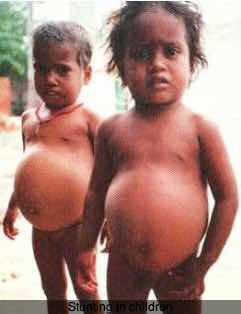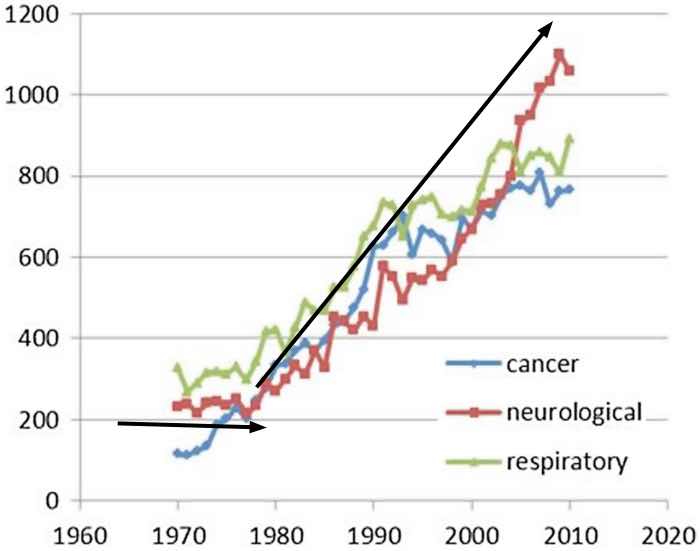- Bernard Preston homepage
- Stunting of children
Stunting of children
The stunting of children begins in the uterus and continues with how the newborn infant is fed. Two definitions are often used to which we add a third.
- Physically it is defined as being in the low height-age bracket.
- Stunting is also defined as poor mental development of children as a result of chronic under-nutrition.
- Over-nutrition from chronic excessive carbohydrate consumption of highly refined foods comes into the equation too.

"Section 28 of the Constitution guarantees our children the right to basic nutrition. And yet 27% of them under the age of five are permanently stunted."
- Dr Jane Battersby
Some children are naturally short and not physically stunted; but worldwide this is reckoned to be no more than 3% of all kids. But in South Africa it has reached epic proportions with 27 percent of those under the age of five falling below the guidelines[1].
Add to that the permanent stuntedness of cognitive-development; now we have a national catastrophe.
This page was last updated by Bernard Preston on 9th January, 2025.
Maternal under-nutrition
Maternal under-nutrition means inevitably a poor start for children who will already be on the path to stuntedness even before they are born.
Adequate balanced protein for the development of a strong and normally tall body is non-negotiable; nor is a complete fatty acid complement for the rapidly expanding brain.
Add to that the multitude of microchemicals required by a strong mother and a healthy child from their food; now one grasps the need for sound nutrition. Just a deficiency of folate or choline would mean the great likelihood of a neural-tube defect; as in cleft lip or spina bifida.
High folate levels can be obtained simply from a glass of freshly-squeezed, unstrained orange juice or a cup of spinach for example; remember that more than half of the nutrients in citrus are found in the pulp. Stunting of children because of
deficiency of vitamin B9 should be extremely rare but it is not.
“There may be occasions when we are powerless to prevent injustice but there must never be a time that we fail to protest.”
- Elie Wiesel
Breast feeding
There is an abundance of research that proves beyond any shadow of a doubt that breast-feeding is the best for the infant. How did we ever come to believe otherwise?
Whether it is the high-quality fats and protein, or the immunity to disease that is passed on, nothing can compare with the breast.
However unscrupulous infant-formula companies have targeted less well educated mothers; and convinced them that their very expensive milk powder is far superior. Nestlé has conceded that 60% of their products are not healthy.
For the wealthy it is less of a problem. But the poor who can no longer afford the formula and cannot return to breast-feeding, it is an unmitigated disaster; stunting of children is inevitable.
Mother's milk is high in one of the omega-3 fats called DHA; an astonishing 25 percent of the grey matter of the normal brain is made up of this nutrient. A deficiency would certainly lead to stunting.
Fatty fish, avocados and free range eggs are the best sources of DHA; dairy from pasture fed cows and freshly ground flaxseed too. None of these are routinely available to the poor; but mother's milk from a well-nourished woman would provide it all.
The first two to three years are generally recognised as the most important; once children reach five, the damage done is permanent and cannot be reversed. Their cognitive development will be impaired too; they will never reach their true potential.
Stunting of children
Stunting of children is not only a Third World problem but is prevalent in the West too, if one includes mental backwardness from poor nutrition.
Stunting affects the development of a baby's brain, whether they will matriculate and their productivity as an adult. A person who is backward as a result of poor childhood nutrition will never reach their full potential as a worker. The fallout on the economy is simply unimaginable.
The data shows that 27 percent of children under 5 are considered short for their age or stunted; and of them 10% are severely effected.
- SADHS 2016.
Kwashiorkor

Kwashiorkor is one of the more obviously severe but less common signs of stunting of children.
It is caused by a severe protein deficiency. The low albumin in the blood results in a drop in the oncotic-pressure in the capillaries provoking the leakage of fluid into extracellular spaces known as ascites; swelling of the abdomen.
Of far greater concern is the less visible poor nutrition of over a half of South Africa's children in many areas that starves them of a meaningful future.
It also starves the country of strong and productive workers who are physically and mentally up to the challenges of a modern economy.
According to Wikipedia, South Africa loses about R15 billion annually in GDP to vitamin and mineral deficiencies arising from malnutrition, to which I would add phytochemical shortages; omega-3 fats would be one of the more obvious examples. They go on to state that it would cost less than 1/20th of that to alleviate the problem[3].
A balanced diet containing all the essential amino acids is absolutely necessary to prevent the stuntedness of Kwashiorkor; simply a couple of eggs each week and a glass of milk a day would go a long way to providing sufficient protein; they are both rich in albumin.
Free range eggs are probably more available to rural children, where the hens can roam unrestricted in cages or barns.
School feeding schemes

School feeding schemes in South Africa are based on polony, a relatively cheap processed meat byproduct known to cause tumours; and ultra-refined maizemeal, deficient in the protein, fat and vitamins found in whole corn. Neither should be allowed within the gates; they destine children to poor health and stuntedness.
Simply contracting with local farmers to supply a head of corn in summer, a glass of milk daily and an egg twice a week should be the aim of every school feeding-scheme; together with greens like spinach or cabbage.
In winter maize meal porridge made from the freshly milled grain would supply most of their needs for carbs. Instead it is ultra-refined from which much of the protein and nutrients have been extracted.
How to grow spinach should be the aim of every rural school.
Many of those who are more financially able enjoy a cola or fruit juice for lunch; and sandwiches made using white bread, spread with margarine. They are little better off.
- The stunting story has three elements
- Stunting story and severe food insecurity
- Stunting story weighs hunger versus malnutrition
- Stunting story recommends local mills for freshly-ground grains
- Stunting story suggests scenarios to restore harmony and balance
- Stunting story ponders what government could do
Prevention of stunting
Lysine in chickpeas may be part of the solution. The World Health Organization recommends consuming 30 mg of this amino acid per day for each kilo of body weight. A 1/2-cup serving contains 486 milligrams[5], enough for a 15kg child.
Total protein requirement for a 15kg child is fifteen grams.
Using dried chickpeas, at R38/kg in 2025 which provides 15 cups, the cost would be a little over one rand per child each day.
With the human brain consisting of more than 60 percent fat, it is no coincidence that mother's milk is very rich in these nutritious lipids; in other animals the preponderance rather is protein so the tiny calf for example can grow physically quickly.
But human children need fat and protein; if either are in short supply there will be mental or physical stunting.
And then children of course need all the vitamins, minerals and phytonutrients that adults require for their well-being.
They too need whole grains and at least seven different coloured foods every day. Yet few children eat corn on the cob any longer; the affluent find it takes too long to chew and for the poor it is simply not available in cities.

There is continuing controversy in research circles about how much carbohydrate children need; all are agreed however that refined starches like white bread, sugary cakes and colas should be kept to a minimum.
There is no doubt that with the average American consuming over half a cup of sugar per day, there is stunting of children in the West too; the effect on the brain and behaviour is more apparent than shortness of stature.
Pellagra
Pellagra is a disease associated with an over-dependance on maize as a staple in the diet. Agricultural workers and the rural poor are particularly vulnerable. The disease affects the skin, gastrointestinal tract and brain; psychiatric manifestations are common.
Subclinical pellagra is highly prevalent in South Africa; a deficiency of B3 also known as niacin. It occurs primarily in countries where maize is the staple carbohydrate; it is low in the amino-acid tryptophan which can ordinarily be converted to the vitamin. Meat, chicken and avocados are rich sources; and legumes too.
The bio-availability of B3 though present in maize is low; reports exist that cooked in the presence of an alkali, known as nixtamalization[8] frees the vitamin. Normally it is bound up in a complex with hemicellulose called niacytin.
Pellagra is common in Asia too amongst those on a subsistence diet of polished rice.
"The African Development Bank says under-nutrition and stunting impact 216 million children in Africa and poor food is linked to nearly half of the continent's youth deaths.
It pegs the economic cost of bad nutrition at 11% of Africa's GDP."
- AfDB president Akinwumi Adesina
In short stunting of children should be rare in countries like South Africa, yet over a quarter of our kids are permanently disabled because of poor feeding schemes. We can expect nothing better from this or frankly any government; is it time to start digging for dignity?
This green mealie risotto made with brown rice is particularly nutritious with all of the vitamins and fibre found in whole grains.
Obesity
Paradoxically many stunted children are also overweight. Research clearly shows that the obesity epidemic in the USA began three years after the release of the McGovern Report in 1977 which made these recommendations.
- Less animal fat
- More whole grains
Americans turned enthusiastically to eating far less eggs, whole milk and butter; they cut the fat off their meat. The unintended and unanticipated consequence that this change had was that they became constantly famished; they felt as though they were starving.
Fat in the diet yields satiety.
Another unanticipated fact that the committee did not appreciate was that the recommended whole grains became increasingly difficult to purchase; millers were extracting the bran, germ and fat from wheat and corn for higher profit margins.
So constantly hungry Americans turned instead to tasteless, highly-refined grains; to which large amounts of sugar and high fructose corn syrup were added for flavour. Hydrogenated fats too were extensively used. The prevalence of the neurodegenerative diseases which was relatively flat prior to 1980, spiked sharply, increasing 5x in the next 30 years.

Obesity and ten years later the prevalence of diabetes also soared.
- Statistics South Africa. South Africa Demographic and Health Survey 2016: Key Indicator Report.
- Why child malnutrition is still a problem in South Africa 22 years into democracy
- Malnutrition in South Africa.
- A mealie a day.
- Chickpeas and lysine
- The three Ds of pellagra
- Prevalence of pellagra; download the PDF
- Nixtamalization
- Niacin food sources
When browsing use right click and "Open Link in New Tab" or you may get a bad gateway signal.
Newsletter
Our newsletter is entitled "create a cyan zone" at your home, preserving both yourself and Mother Earth for future generations; and the family too, of course. We promise not to spam you with daily emails promoting various products. You may get an occasional nudge to buy one of my books.
Here are the back issues.
- Lifestyle and ideal body weight
- What are ultra-processed foods?
- Investing in long-term health
- Diseases from plastic exposure
- Intensive lifestyle management for obesity has limited value
- A world largely devoid of Parkinson's Disease
- The impact of friendly bacteria in the tum on the prevention of cancer
- There's a hole in the bucket
- Everyone is talking about weight loss drugs
- Pull the sweet tooth
- If you suffer from heartburn plant a susu
- Refined maize meal and stunting
- Should agriculture and industry get priority for water and electricity?
- Nature is calling
- Mill your own flour
- Bake your own sourdough bread
- Microplastics from our water
- Alternative types of water storage
- Wear your clothes out
- Comfort foods
- Create a bee-friendly environment
- Go to bed slightly hungry
- Keep bees
- Blue zone folk are religious
- Reduce plastic waste
- Family is important
- What can go in compost?
- Grow broad beans for longevity
- Harvest and store sunshine
- Blue zone exercise
- Harvest and store your rainwater
- Create a cyan zone at your home
Did you find this page interesting? How about forwarding it to a friendly book or food junkie? Better still, a social media tick would help.
- Bernard Preston homepage
- Stunting of children
Address:
56 Groenekloof Rd,
Hilton, KZN
South Africa
Website:
https://www.bernard-preston.com
